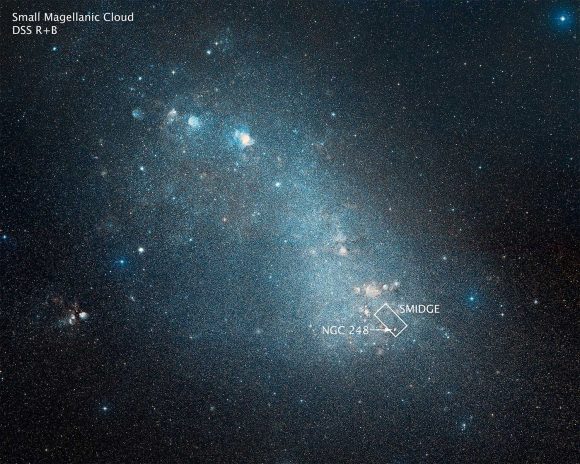The Hubble Space Telescope has revealed some amazing things over the past few decades. Over the course of its many missions, this orbiting observatory has spotted things ranging from distant stars and galaxies to an expanding Universe. And today, twenty-six years later, it is still providing us with rare glimpses of the cosmos.
For example, just in time for the holidays, Hubble has released images of two rosy, glowing nebulas in the Small Magellanic Cloud (SMC). These glowing clouds of gas and dust were spotted as part of a study known as the Small Magellanic Cloud Investigation of Dust and Gas Evolution (SMIDGE), an effort to study this neighboring galaxy in an attempt to better understand our own.
The images were taken by Hubble's Advanced Camera for Surveys (ACS) in September 2015 and feature NGC 248 - two gaseous nebulas that were first observed by astronomer Sir John Herschel in 1834 and are situated in such a way as to appear as one. Measuring about 60 light years in length and 20 light-years in width, these nebulas are among a series of emission nebulas located in the neighboring dwarf satellite galaxy.

Small and Large Magellanic Clouds over Paranal Observatory Credit: ESO/J. Colosimo
Emission nebulas are essentially large clouds of ionized gases that emit light of various colors - in this case, bright red. The color and luminosity of NGC 248 is due to the nebulas heavy hydrogen content, and the fact that they have young, brilliant stars at the center of them. These stars emit intense radiation that heats up the hydrogen gas, causing it to emit bright red light.
As noted, the images were taken as part of the SMIDGE study, an effort on behalf of astronomers to probe the Milky Way satellite - which is located approximately 200,000 light-years away in the southern constellation Tucana - using the Hubble Space Telescope. The ultimate goal of this study is to understand how dust is different in galaxies that have a far lower supply of the heavy elements needed to create it.
In the case of the SMC, it has between one-fifth and one-tenth the amount of heavy metals as the Milky Way. In addition, its proximity to the Milky Way makes it a convenient target for astronomers who are looking to better understand the history of the earlier Universe. Essentially, most star formation in the Milky Way happened at a time when the amount of heavy elements was much lower than it is now.

Ground-based image of the Small Magellanic Cloud. showing the area of the SMIDGE survey and the position of NGC 248. Credit: NASA/ESA/Hubble/Digitized Sky Survey 2
According to Dr. Karin Sandstrom, a professor from the University of California and the principle investigator of SMIDGE, studying the SMC's can tell us much about neighboring galaxies, but also about the evolution of the Milky Way. "It is important for understanding the history of our own galaxy, too," he said. "Dust is a really critical part of how a galaxy works, how it forms stars."
In addition to the stunning images, the SMIDGE team and the Space Telescope Science Institute have also produced a video that shows the location of NGC 248 in the southern sky. As you can see, the video begins with a ground-based view of the night sky (from the southern hemisphere) and then zooms in on the Small Magellanic Cloud, emphasizing the field where NGC 249 appears.
Check out the video below, and have yourselves a Merry Christmas and some Happy Holidays!
Further Reading: NASA






No comments:
Post a Comment